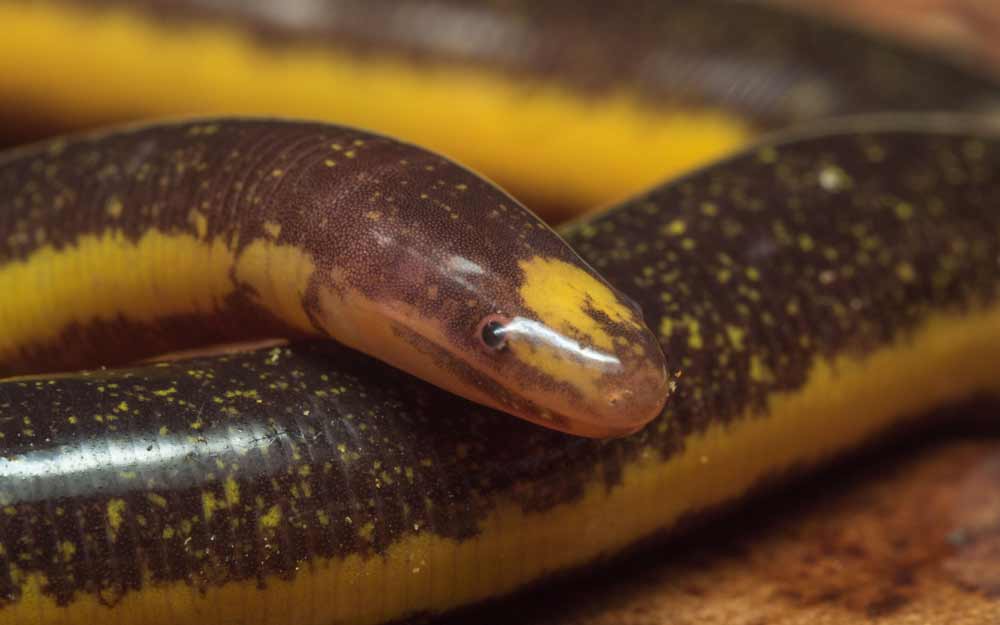The research is a textbook example of how predatory pressure on the caecilians caused an evolutionary cascade to resist snake venom.
Caecilians, those legless amphibians that resemble earthworms in some respects, have evolved to develop resistance to alpha neurotoxic snake venoms, making them less susceptible to the venoms of elapid snakes.
According to a team international researchers studying the amphibians on all the continents, including the Seychelles Islands where there are no elapid snakes, the caecilians have developed three types of resistance to snake venom and this resistance evolved 15 times across the caecilian tree, including three times in Africa, seven times in the Americas and five times in Asia.

Siphonops annulatus Photo by Dias I, Medeiros T, Vila Nova M, Solé M /Wikipedia
“One kind is putting up a form of barricade that blocks the ability of the toxins to reach receptors that would normally elicit a deadly reaction,” University of Queensland Associate Professor Bryan Fry, lead author of the study said in a statement released by the university. “A second form of resistance is changing the physical shape of the receptor. As the toxins have evolved to be like keys and insert into the lock-like receptor, changing the shape means the toxin no longer fits. Lastly, caecilians essentially deploy an electromagnetic ‘weapon’ which reverses the charge during this toxin-receptor interaction.”
Researchers Record First Instance of So-Called Penis Snake In Florida
Snake-like Amphibian Siphonops annulatus Have Venom Glands, New Study Says
Fry said the research is a textbook example of how predatory pressure on the caecilians caused an evolutionary cascade that is the same as fighting the venom with their own evolution. It was the rise of the elapid snakes such as cobras and coral snakes that deliver venom via hollow, syringe-like fangs that caused the caecilians to change their chemical makeup to fight off the venoms of these reptiles.
“The caecilian’s ability to persevere and evolve despite these pressures is like a movie—like the survivors of Judgment Day fighting back by changing the chemical landscape,” Fry said in a statement released by the University of Queensland.
The researchers also noted that several caecilian species retain multiple resistance and say that the amphibians have gone through at least 20 separate events that involve the origin of toxin resistance.
“Elapid snakes are the dominant venomous snake predators in the fossorial niche and have been documented as preying on caecilians,” the researchers wrote in their study.“We hypothesized that caecilians are therefore under strong selective pressure to evolve resistance to elapid venom. As caecilians spread geographically prior to the evolution of elapid snakes, we further hypothesized that the examination of additional species would reveal evidence of widespread convergent evolution.”
The researchers collected tissues tom sequence the neuromuscular receptor in the caecilians that are bound by the snake venom’s toxins.
We showed that resistance to elapid snake venom neurotoxins has evolved on at least 15 times—which is absolutely without precedent,” Lead author, Marco Mancuso from Vrije Universiteit Brussel’s Amphibian Evolution Lab said. “A particularly interesting validation of the theory was that the caecilians on the Seychelles islands were not resistant to snake venom, which is consistent with elapid snakes never reaching those islands.”
“It’s an extraordinary signal for response to such severe selection pressure, where the survivors of the onslaught were those who were a bit less sensitive to the venom and some had mutations that made them completely immune. These were the ones that repopulated the earth after the elapid snake plague.”
The complete paper, “Resistance Is Not Futile: Widespread Convergent Evolution of Resistance to Alpha-Neurotoxic Snake Venoms in Caecilians (Amphibia: Gymnophiona)” can be accessed on the International Journal of Molecular Sciences website.


